Spore Origins is a circumscribed version of the Cell Phase from the PC game Spore, and that's a good thing. The PC game has gotten mixed reviews, perhaps because it tries to do too much, but Spore Origins does much less much better—as long as you are playing it on an iPhone or iPod touch, that is. If you've ever seen a game on another phone besides an iPhone, you will never want to again. Spore Origins is one of those games that makes the benefits of a real OS on a portable device immediately clear to people who have no idea what "OS" stands for. After playing the entirety of the game, there is much good and just a little bad to say about Spore Origins. Somewhat surprisingly, the good begins with the most controversial aspect of gaming on the iPhone and iPod touch.

In Spore Origins, the accelerometer just works!
In Spore Origins, your character is a tiny creature whose purpose is simply to survive. This is accomplished through the 30 levels of game play by "collecting DNA," that is, by eating smaller creatures. Having named your creature, the game begins with a tutorial level teaching basic movement.
Unlike Super Monkey Ball—which made me blue with frustration—Spore Origins gets the accelerometer right. I would argue that it's better than the traditional directional pad. Tilt in a direction to move in a direction. Tilt more to move faster. That's pretty much it. It takes about 30 seconds to get comfortable with the control scheme. You can also set the neutral position of the tilt feature in the options, that way you don't have to always hold the device parallel with the ground.

Is it just me, or do those evoke thoughts of sperm? And what does that say about me?
Game play itself is pretty simple. You eat creatures to fill the DNA bar on the left and increase health on the right. Increasing health makes your creature grow larger, allowing it to eat bigger creatures. You can also boost your score by performing "combo" moves, which is really just catching a cluster of prey at one time for a multiplier bonus. The downside of this is you lose control of your creature during such a feeding frenzy, which might result in damage from collisions with predators. Damage from attacks by other predators causes your creature to shrink until it becomes extinct. Completing most levels takes only a few minutes, and that should make it clear Spore Origins is strictly a casual game, but there is an element of casual strategy too.
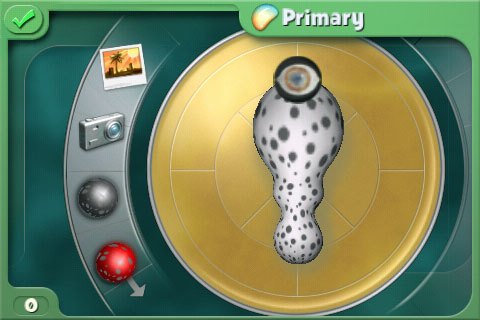
Choose primary and secondary colors, as well as patterns, including using photos
There is a fecundity of choice in Spore Origins that makes it a memorable experience as much as a casual game. After the tutorial level, your creature is presented to you in a petri dish where you can make modifications. At first, you are limited to how the creature looks, choosing the color and patterns of the skin, as well as the general shape. Using the interface superiority that is multi-touch, you can pinch and pull to alter the general shape of the creature. While such changes don't affect play, they do affect the player. I wanted to make the creature my own. At later stages where modifications matter to game play, I noticed a tension between wanting my creature "to look a certain way" and a desire for efficacious game play—anthropomorphism for the win, EA!

The four paths of evolution: perception, movement, defensive, offensive
As you progress through Spore Origins, you earn evolutionary "part points" that you can use to edit your creature, but it's not really evolution because spent points can be recouped by removing a part. While this might offend purists, it allows for a broader gaming experience without having to create multiple creatures and play simultaneous games. By the end of the game, you'll get all the regular parts, but you can have only one "super part" at any time. A super part is activated by touching the screen, and must recharge between uses. The following is a critique of parts that may spoil the game for some, so read with that in mind.
Offensive
- Probe: damage and stuns—my first choice
- Mandible: increased damage, but wait for it
- Electric: powerful attack, but non-directional, pass
Defensive
- Scales: reduces damage—second choice
- Spikes: repel and damage—fourth choice
- Shell: temporary invulnerability, but no movement—pass
Movement
- Tail: speed boost, third choice
- Fins: better mobility for avoiding attacks, mid-game choice
- Jets: speed boost, plus damage bonus when attack—my super part pick
Perception
- Eyes: comes with creature, bonus when eating—keep
- Antennae: points towards food off screen—mid-game must
- Lure: supposed to use when against larger creatures to fool—couldn't get to work
Of course, any changes to your creature are reflected during game play, complete with animations. But modifying your creature comes later in the game.
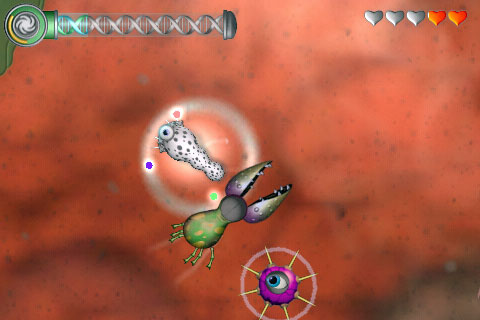
Power up with temporary symbiotes found in some levels: speed, shield, and poison
Early in the game, it's important to quickly figure out who can be eaten and when. This is made a little difficult at first because the game looks so damn good you just want to watch it. While the format is a two-dimensional platformer, the backgrounds move separately—looks like the inside of lava lamps—and occasionally in the distance, the form of some huge predator can bee seen floating by—nice touch. In the foreground is the immediate environment and creatures, and the level of graphics detail is amazing, certainly as good or better than what you see on a Nintendo DS. The sound effects and music are also great—I like the screams creatures make when eaten—both of which can be silenced, but no iPod music during game play.
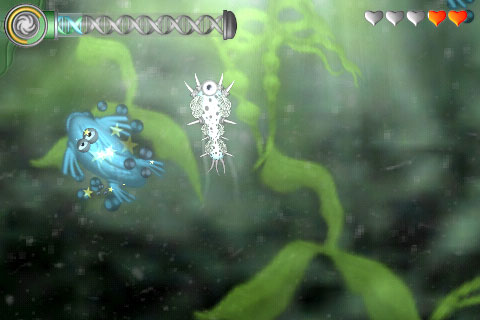
One fish, two fish, kill the bluefish—but not the green!
Getting back to play, who you can eat depends upon your health status. The more health (hearts) you have, the larger your creature and the greater the number of other creatures that can be eaten. Even then, some creatures have defensive capabilities, like spikes or poison, so dine with care. Even if you can't eat some creatures, you can usually stun and damage them, a health bar appearing as they progressively weaken until death. While most levels require your creature to fill the DNA bar, this not always so.
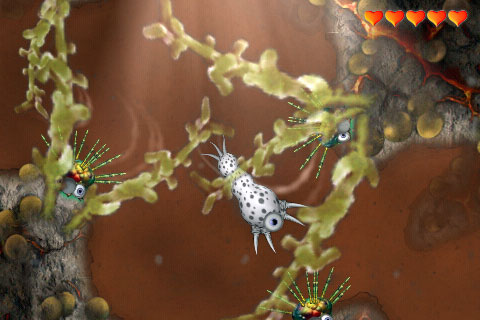
Currents can be seen as waves in the background
Maze levels don't have a DNA bar, but they do require you to follow some path from start to finish. You can still eat, of course. In fact, it's pretty much required, because you will take damage as you make your way through maze levels. The game gives casual-type hints by using "currents" to drive you in the right direction.
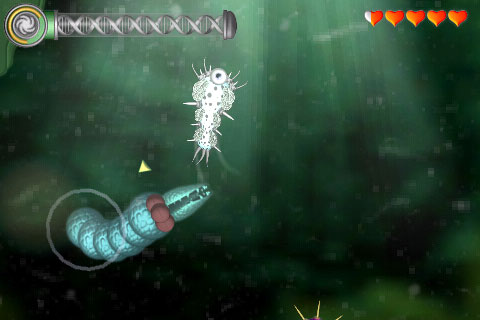
The antenna part points towards food, in this case the eel's bottom
Later in the game, you will find a creature or two that function as sort of a boss of a level. This is especially true of the last two levels, which are non-casually difficult. To beat those levels, you will have to die repeatedly before succeeding. Choices for parts, especially super parts, matter too, but eventually your creature will persevere, ending the game.

Survival mode, when you don't have five minutes to kill playing Evolution mode
So, what's not to like about Spore Origins? My biggest complaint is that the game ended too quickly. I wanted more levels with bosses that required a strategy to defeat. I was also disappointed to find the online interactivity that is apparently found in versions for other mobile devices is not available for the iPhone and iPod touch. Not only can you not share your creatures, there aren't even online high scores.
There is also a mini-game, Survival, that is unlocked during during standard play. In it, a generic creature chases food pellets while avoiding enemies that look like three eyeballs clustered together. There are also power-ups, but it's still boring. At best, it should have been a freebie at the App Store to entice people to buy the real game. Still, a desire for more game, minor annoyance at a lack of online options, and a crappy mini-game, that's not much bad against a lot of good.

See Spot kill. Kill, Spot, kill! Good Spot.
There's a reason Apple chose to show off Spore Origins at not one, but two Apple Events, and it's not because Apple is kissing EA's ass to get product—that behavior is reserved for NBC. When Steve Jobs said of the iPod touch, "you could make the argument that it's the best portable device for playing games," for once it could be more than typical Jobs' hyperbole. Excellent content, visually stunning, and a user interface that is actually superior to the traditional directional control pad, these are the real arguments for the best portable device for playing games, and that is Spore Origins on the iPhone and iPod touch.
Game: Spore Origins
Publisher: Electronic Arts
Size: 79.9 MB
Price: $9.99

reader comments